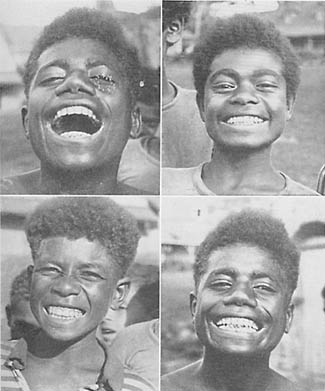
One origin of physical deformities
FACES are classified on the basis of physical characteristics and appearances which identify them as having a common ancestry. The constant reproduction of ancestral patterns constitutes one of the fundamental laws of heredity. We are concerned here with the divergences from the normal course of reproduction.
The precision with which Nature reproduces widely distributed racial stocks demonstrates how deeply seated and controlling are the Mendelian laws. In Fig. 98 may be seen four young men of the Melanesian race born on four different islands. They have never seen each other, yet they look like brothers. Similarly, in Fig. 99 are shown four Polynesian girls. Here again they look so much alike that they might readily be taken for sisters. Yet, they live in four different groups of Polynesian islands; the Hawaiian, the Samoan, the Tahitian, and the Rarotongan.

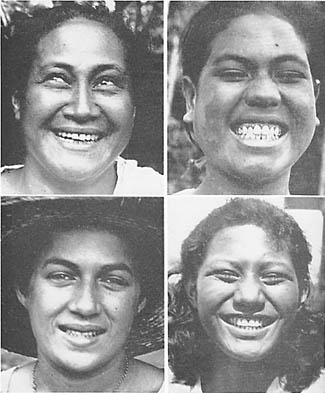
The blending of different racial stocks produces typical characteristics of either or both ancestral patterns. When, however, marked divergences appear without mixing of racial stocks, the result is not due to heredity, but occurs in spite of heredity. In the previous chapters, I have shown that in the modernized groups of various primitive racial stocks, ccrtain individuals developed marked changes in facial and dental arch form from the racial pattern. We are interested to know the nature of the forces responsible for this distortion of the ancestral pattern. In a study of 1,276 skulls of the ancient civilizations of Peru, I did not find one with a typical divergence from normal such as we find in modern whites or in children of primitive racial stocks after the parents have adopted the foods of our modern civilization. It is important that we study this phase in further detail.
In Fig. 100 are shown two Indian fathers and their sons, whom we studied in Peru. The father and son shown above lived at Talara, in a highly modernized Indian colony. The father worked in the oil fields on the coast. This district is an arid desert into which practically all food has to be shipped for the large colony engaged in the oil industry. The father was born while his parents were using the native foods of the coast, including an abundance of sea foods. The son was born to his parents after they had adopted the foods of modern civilization. The father and son shown below, lived in the high Sierras. The father is an Indian descendant of the Incas and was born while his parents were living on the native dietary of the high plateau country, near Cuzco. After the adoption of the modern foods by the parents, the son shown to the right was born. It is important to keep in mind that the marked change in these fathers and sons has occurred in the first generation after the parents have adopted the white man's foods, and has occurred in spite of heredity.
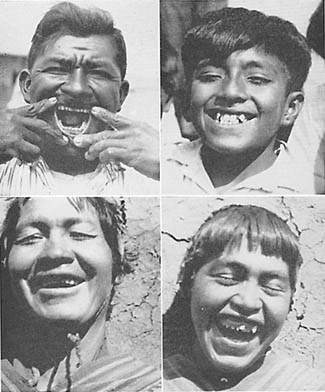
In Fig. 101 above is shown a Wakamba father in central Africa, a man who is working for the railroad company which contributed largely to the food supply for the laborers. The boy shown at the right was born after the parents had adopted the imported foods. In the lower picture, in Fig. 101, is seen a Fiji Islander and his son. The father was born to parents living on the native foods, and his son was born after the adoption of the white man's foods. All these are typical cases of the inhibition of Nature's normal procedure. We have additional data which indicate that our problem is associated with a progressive lowering of reproductive capacity on the part of one or both of the parents.

In photographing the members of modernized families, regardless of racial stocks, we frequently find that changes in facial expression appear in the younger members of the family. This change in facial contour within a family does not occur in the primitive races, while on their native dietary.
In contrast with this we see, in Fig. 102, two sisters and two brothers. In each pair there is a marked change in the facial form of the younger. The arches and the nostrils of the younger child are narrower and there is a marked lack of development in both the middle and lower thirds of the face.
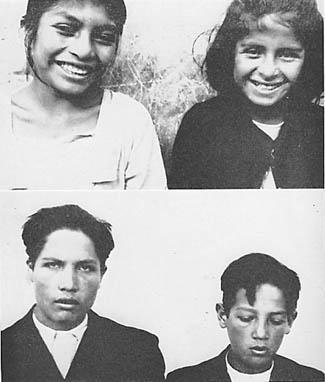
Very striking illustrations of this progressive degeneration in the children of a given family were found among the modernized aborigines of Australia. Two views of brothers are shown in Fig. 103 (upper). The father and mother of these two boys were born in the Bush. They were living, when photographed, in one of the reservations, on the imported modern foods which were provided by the government. This is also illustrated in the lower photograph. Note the marked underdevelopment of the middle third of the face of the girl.
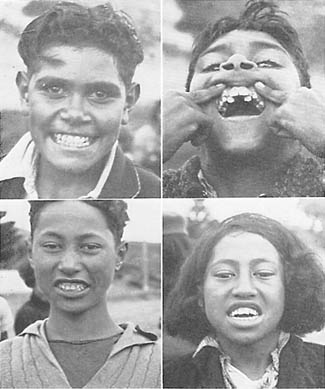
Striking instances were frequently seen among the modernized Maori of New Zealand. Two sisters presenting two extremes of facial form are shown in the upper section of Fig. 104. The girl to the left is the older. She has the typical tribal pattern which has been completely lost in her younger sister to the right.
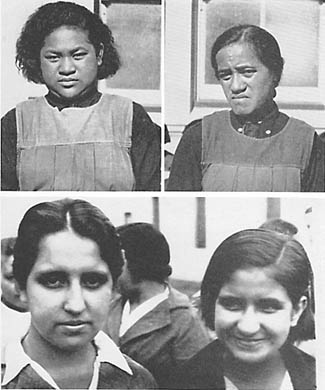
If the change in facial form were the result of racial admixture, we should not have the types of deformity patterns that these cases show. Indeed, in the same family we should not find several different deformity patterns. The lack of development downward of the upper anterior incisors and the bone supporting them is illustrated for the younger child, in Fig. 103 lower right. It will be noted that when this girl's molar teeth are in contact her front teeth still miss occluding by a considerable distance.
Members of the white race are affected in a similar manner. In Fig. 104 (lower) are shown two sisters; the younger to the right reveals strikingly the lack of development of the middle and lower third of the face. The fact that this condition so frequently shows a progressively severe injury in the younger members of the family is a matter of great importance in tracing the causative factors. It is important to keep in mind that when the injury shows in the face of the young child it becomes worse when the adult face forms. This increase in deformity occurs at the time of the development of the permanent dentition, at from ten to fourteen years of age.
In the islands north of Australia where contact with modern civilization is just being made, the adult individuals showed a constant reproduction of the tribal pattern, while those born since contact was made, had many divergences from normal. In Fig. 105 will be seen a family of six individuals. Four were born before the modern store was put on that island and two after the parents had come into contact with the influence of the imported foods. It will be seen that the four older brothers show marked uniformity of facial design, and that all have reproduced the tribal pattern. The two younger members show definite change in facial pattern. This is also illustrated in Fig. 106 above, in which the oldest brother was born before the store was put on Badu Island, and the three younger, after the establishment of the store twenty-three years ago.

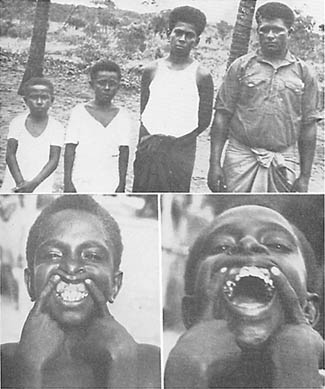
This problem of progressive degeneration in the younger members of the family is again illustrated by the group shown in Fig. 107. The older girl has reproduced the tribal pattern of the race with normal broad, dental arches. The second girl shows marked narrowing and lengthening of the face. The third child, a boy, shows very marked divergence from the tribal pattern. This group is shown below with their teeth exposed. It will be seen that the oldest girl has broad dental arches typical of Nature's normal design. The second girl has a marked depression laterally in the molar and bicuspid region producing a narrowing of the palate. The third child has in addition to the narrowing of the face a marked deficiency in bone growth so that the cuspids both above and below are forced entirely outside the arch. The total circumference as well as the breadth of the upper arch is so reduced that space is not available for the cuspids. They will be seen imbedded high in the tissue, as illustrated in the lower picture of Fig. 106.
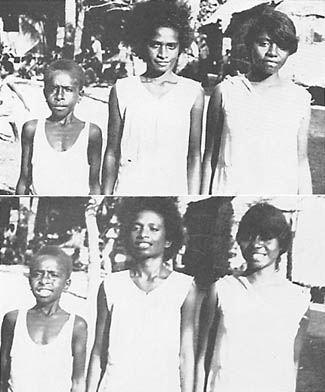
Fig. 108 shows three white girl scouts in New Zealand. Note that progressive narrowing of the body including both shoulders and hips has occurred in the younger members of the family. This is also shown in Fig. 107.
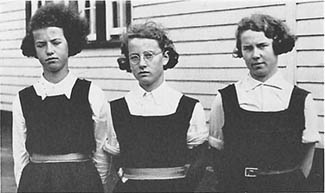
It would be remarkable if these disturbances in the physical pattern were limited to the face and dental arches. An illustration of other deficiency injuries is shown in Fig. 109, which shows three children in a modernized Maori family. It will be seen that while the oldest girl has the typical Maori racial pattern of face, there is a marked lack of development of the middle third of the face, with progressive severity of distortion in her two younger brothers. On observing the feet it will be seen that she has splendidly formed feet while the second child has flat feet, and the third child has clubbed feet.
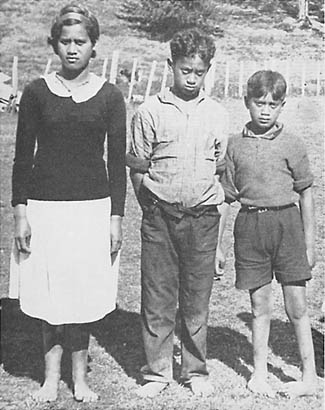
I have found similar examples in several of the modernized primitive racial stocks. The severity of the disturbing factors may be different under different circumstances. Drought, industrial depression, unemployment, and the like, all have their influence. In Fig. 110 will be seen three Maori children of New Zealand; the second child is smaller in stature than the third and gives more evidence of facial injury. While his older sister and younger brother have normal feet, his quite severe disturbance in facial growth is associated with club feet.

I have one patient who was the seventh of a family of eleven children. All the children in the family have good facial development, except this patient. She was born in the midst of a severe financial depression when the total amount of money available for the food for the family was reduced to a very low level. The other children were born before or after the depression, and were not injured. In addition to this patient's severe facial deformity, she has had some arthritis and a general rheumatic tendency. Her facial injury is marked and is characterized by a lack of development of the middle third.
Deformities of the feet associated with facial deformity have been found in several modernized groups of primitive racial stocks. A typical case among the modernized Indians of Peru is shown in Fig. 111. The face of this boy shows abnormal development with narrowing of the upper arch and displacement of the teeth. This is associated with gross deformity of one foot and shortening of the leg. He lives in the high country. This phase is strikingly illustrated in Fig. 112 where the face is very badly injured and both feet are seriously clubbed. This boy is a Coastal Indian.

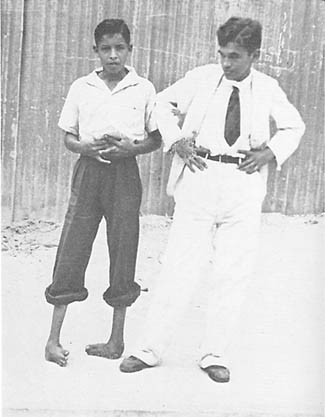
The serious expressions of physical deformities which we found had occurred in several primitive racial stocks, after they have become modernized sufficiently to be using the foods of our modern civilization, are occurring in our modern American families with equal severity and great frequency.
One method for determining the cause of these deformities is through an examination of birth and death certificates to note the recorded data relative to physical deformities. An outstanding contribution to this approach has been made by Dr. D. P. Murphy, of the University of Pennsylvania. In an examination of 130,132 individual death certificates that have been recorded between 1929 and 1933, he found physical deformities recorded in 1,476 cases. Dr. Murphy sent field workers to make a personal study of the family histories by contacting the mothers or grandmothers, of whom they were able to locate 890. From this group he was able to select 405 with sufficiently complete family histories to allow tabulation in a form that would throw light upon the birth rank and other data. His studies strongly emphasize the presence of a period of low reproductive activity. In concluding one of his reports he states: (1)
Miscarriages, stillbirths, and premature births occurred more often than would be expected by chance in the pregnancies immediately preceding and immediately following the pregnancy which resulted in the birth of a defective child, and less often than would be expected by chance in the remaining pregnancies. Miscarriage, stillbirth, and premature birth occurred most often in the pregnancy immediately preceding that of the defective child.
From the above observations, it is concluded that the birth of a congenitally malformed child may be only one expression of a prolonged decrease in functional reproductive activity, the other expressions being miscarriages, stillbirths, and premature births.
It is suggested that the obstetrician has unusual reason to suspect the possible existence of a congenital malformation in the pregnancy which follows immediately after a miscarriage, a stillbirth, or a premature birth.
Shute, of the University of Western Ontario, London, Canada, in a personal communication, states that he has been impressed, in his studies of aborted fetuses, with the large percentage that are malformed. This seems to link the malformations with the causative factors which have resulted in decreased reproductive activity.
In connection with the production of imperfect infants, the period in the formative process at which the injury occurs and also its origin are important. Murphy has thrown important light on this phase in his study of the cause of the defectives in forty families with two or more malformed. (2) He concludes: "Many if not most of the congenital malformations met with in this study resulted from defects in the germ plasm, which were present before fertilization."
Among the important questions that arise is the relative responsibility of the two parents. As an approach to this phase Murphy (2) has made a study which deals with a consecutive series of 884 families in each of which there appeared at least one congenitally malformed child. In forty of these families, there were two or more malformed brothers and sisters. He presents extensive data in tabular form from which he takes examples to illustrate his interpretation. He states under the "Clinical Value of Study" the following:
It is evident from the above data (tables) that there is a strong tendency for congenital malformations to duplicate in siblings that belong to a consecutive series of families. And also that such defects tend to appear rather frequently among their more distant relatives. This duplication of malformations is to be observed in the case of the more serious types of defects, just as it is noticed in the less serious ones. These findings lend support to the theory that congenital malformations are primarily the result of influences which affect the germ cells prior to, rather than after, fertilization. The validity of this theory is emphasized by three examples taken from Tables I and II. Family 17 in Table I contained 3 children with pyloric stenosis, two of which were twins. Family 6 in Table II possessed 2 siblings with cleft palate, conceived by the same father, but born to different mothers. Family 8 in Table II contained 2 children both exhibiting an absence of the right half of the diaphragm. It does not seem likely that such sequences of events as these could be the result of any forces that did not operate until after fertilization had taken place. . . .
Since, as has been shown in a previous report, congenital malformations are 24 times more common in siblings of defective children than in the population at large, the present observations should be of added clinical interest.
Summary and Conclusions
- A consecutive series of 40 families having 2 or more congenitally malformed children has been studied with respect to the duplication of defects in siblings.
- The defect observed in the first malformed child reappeared in a subsequent malformed sibling in about 50 per cent of all cases; the 50 per cent remaining including all other possible defects.
- In a second group of 39 consecutive families, in which a malformed child possessed a malformed relative, the malformation in the child and in the relative were identical in about 41 per cent of cases.
- In 19 non-consecutive families with 2 or more malformed children, the defect of the first child repeated in a subsequent child in over half of the families.
It is significant that while these important factors are just coming to light in our modernized civilization, the evidence clearly indicates that several so-called primitive races have been conscious of the need for safeguarding motherhood from reproductive overloads which would reduce the capacity for efficient reproduction. For example, G. T. Baden (3) in his book "Among the Ibos of Nigeria" states:
It is not only a matter of disgrace but an actual abomination, for an Ibo woman to bear children at shorter intervals than about three years. . . . The idea of a fixed minimum period between births is based on several sound principles. The belief prevails strongly that it is necessary for this interval to elapse in order to ensure the mother being able to recuperate her strength completely, and thus be in a thoroughly fit condition to bear another child. Should a second child be born within the prescribed period the theory is held that it must inevitably be weak and sickly, and its chances jeopardized.
Similarly, the Indians of Peru, Ecuador and Columbia have been familiar with the necessity of preventing pregnancy overloads of the mother. Whiffen (4) in his book "North-West Amazons" states:
The numbers (of pregnant women) are remarkable in view of the fact that husbands abstain from any intercourse with their wives, not only during pregnancy but also throughout the period of lactation--far more prolonged with them than with Europeans. The result is that two and a half years between each child is the minimum difference of age, and in the majority of cases it is even greater.
It may also be important to note that the Amazon Indians have been conscious of the fact that these matters are related to the nutrition of both parents. Whiffen states that:
These Indians share the belief of many peoples of the lower cultures that the food eaten by the parents--to some degree of both parents--will have a definite influence upon the birth, appearance, or character of the child.
This problem of the consciousness among primitives of the need for spacing children has been emphasized by George Brown (5) in his studies among Melanesians and Polynesians in which he reports relative to the natives on one of the Solomon Islands as follows:
After the birth of a child the husband was not supposed to cohabit with his wife until the child could walk. If a child was weak or sickly, the people would say, speaking of the parents, "Ah, well, they have only themselves to blame."
These new data have a very important bearing on the problems of degeneration in our modern civilization. Since it is true that a racial pattern can be changed in a single generation our modern concept and teaching with regard to the role of heredity must be modified, in its relationship to cause and effect. A deformity arising from intercepted heredity is just as truly biologic as a deformity arising from accumulated impacts as expressed in heredity. Instead of blaming the past generations for the distortions or frailties of our modern generation and thus relieving our own generation of responsibility these new data indicate that the social organization that is creating these divergencies from normal must alone accept the responsibility.
This completely changes some aspects of the theories and practice of modern social education. Instead of planning the care and management of distorted personality as though the lesion were the result of environmental influences upon a normally organized individual, it should be looked upon as a distortion affecting one link in the chain of heredity which is neither the result of the distortions of previous links nor a controlling factor for future links in the chain. The prognosis, in other words, while being bad for the individual is not necessarily bad for his or her descendants.
While many of the individuals who have suffered physical distortions have apparently practically normal brain development we shall see in the following chapter that a certain percentage have so great a disturbance in brain organization that they cannot and should not be considered as individually responsible for their behavior.
It is urgent therefore that the data presented in this chapter be looked upon as an important key to the progressive degeneration that is taking place in many parts of the world under the influence of our so-called modern civilization. It is a matter of profound significance that the most primitive races were originally able to avoid the physical degeneration so general in many communities today. It is also a matter of importance that the primitives recognized not only these dangers but were conscious of and practiced adequate means for preventing them. They had sufficient character to achieve the ends which they deemed essential. Weakness in character may constitute the greatest barrier in the reorganization and conservation of our modern civilization.
Two serious defects from which many individuals in our modernized civilization suffer are impacted teeth and the absence of teeth due to their failure to develop. It is significant that in the arches of the primitive races practically all teeth form and erupt normally, including the third molars. In the modernized primitives and among our modern whites with deformed dental arches many teeth are impacted and often several of the permanent teeth have never formed. The evidence indicates that this, like the facial and dental arch deformities is due to an absence of vitamin A in the diet of the mother during the gestation period or of one or both of the parents prior to conception. The cause is discussed in the next chapter.
References
Next
Table of Contents
Back to the Small Farms Library